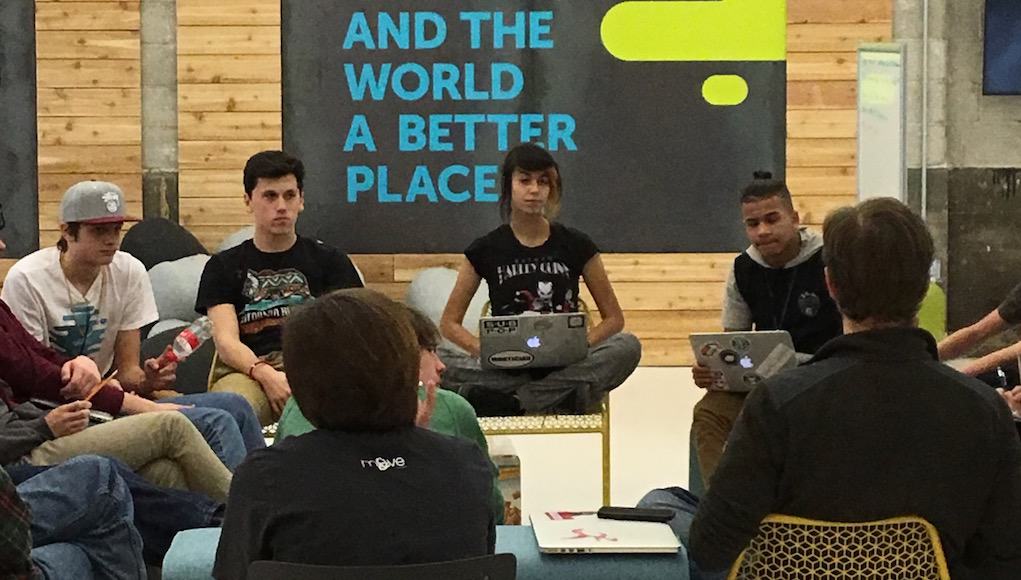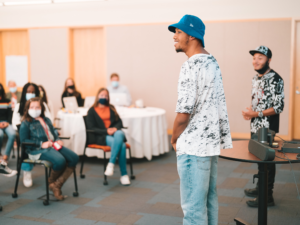8 Tips for Helping Students Identify and Solve Big Problems

By Megan Mead
Over the past year, our team has been investigating how to prepare students for an increasingly project-based world through our It’s a Project Based World campaign. The more we learned from powerful educators across the country (and the globe), the more we realized that at its core, project-based learning allows students to explore passions and potential passions to better understand the world around them, as well as the core academic content that we have traditionally linked to “school.”
But great learning experiences require more than just a connection to passion (most often that is the easy part), they require that students experience complexity, rigor and a series of supports that ensure all students are given the opportunity to achieve. As educators seeking to create meaningful experiences for our students, we must find ways to ask the right questions and provide kids the space to come up with their own problems. Not only do we need to ask questions that students feel are worth addressing, but we need to help them identify the problems that they truly care about.
When we create environments that spark curiosity, our kids will come up with the best questions. And when they do, the adults can step out of the way and allow students the space to explore the nuances, depth and ambiguity which compose life.
1. Creating environments that spark curiosity. First and foremost, students in a classroom environment won’t feel comfortable diving into the unknown unless the classroom culture is one of belonging and one that celebrates vulnerability. It’s tough to get them to try to solve real problems if we do not have a culture that supports children in venturing an answer to questions that may not have exact answers. Do kids in your classroom feel comfortable asking questions?
2. Model with interesting questions. Kick off each lesson with a question–one that incites curiosity and promotes inquiry. Examples include, “Where did the first human come from?” (There’s not really a definite answer to this; it’s complicated, and could require students to really dive into different subject areas), or “what makes us human?” (which could go backwards to science, noting the differences between different species before humans evolved to discussions about machine learning and artificial intelligence). As I mentioned in my first point, this type of inquiry cannot happen in a classroom where ideas are shut down or where students don’t feel comfortable. This is a key opportunity to dive into culture and perspective, but students have to be willing to be vulnerable. What question could you start your next lesson with?
3. Get students outside. The real world is full of issues and problems; get students to think about their world and what problems exist within it. Helping students find connection to specific problems will help develop a passion for solving them. Conducting interviews with local business owners, going on a bus to the city to explore, or heading to a local park for observations outside can yield lots of interesting questions (see Place-Based Education). What unique resources are available to you in your community?

4. Involve adults. Encourage as many different types of professions to come into the school as possible, and vice versa. Get students interviewing adults from a plethora of different careers. Have them ask, “What problems do you solve in your work?” Then, get to work formulating which questions your classroom could tackle. Do your students have access to adults outside of the school building?
5. Network. Allowing students to explore passions means that the teacher can no longer be the only source of information. Show students how to responsibly connect with experts outside your own community with tools like LinkedIn or resources from organizations like Roadtrip Nation. What current project or lesson would benefit from an outside expert?
6. Dedicate Time. A recent visit to TAF Academy in Federal Way, Washington reminded us how important it is to set aside dedicated time for students to direct their own learning. Caitlin Engel, a digital arts teacher at the school whose classroom we visited, was in the middle of giving her students a “genius hour”—the standard Monday schedule in her class, modeled off of Google’s practice of giving engineers 20% of their time to work on personal passion projects (a practice leading to many of the company’s innovations and new products). Ms. Engel’s students were writing novels, building awareness campaigns and starting companies… not bad for a Monday. How could you embed more exploration into your week?

7. Encourage Passions. Encourage them to think about the impact that they want to make, and support them in thinking through how they will do it. The future that we are preparing our students for is drastically different than the world that we went to school for. Now more than ever, skills like problem-solving, critical thinking, empathy and collaboration are increasingly important. But the opportunity to connect your work to your passion is also bigger than it has ever been. Show your students examples of young people charting their own paths and making unique contributions to the world. Do you know what your students are really passionate about?
8. Prepare for deep conversations. When starting to open the door to deep questions, teachers should be thoughtful on how they respond and engage in these types of conversations. Use discussion guides, prompts and classroom protocols to support ongoing questioning. Do you ask or answer questions?
Classroom teachers aren’t the only ones thinking about how to support deeper problem-solving. I asked our friends at Discovery Education how they ensure students have the opportunity to engage in work that is real, engaging and personally meaningful.
“We constantly hear from teachers in the field that boosting students’ engagement in instruction is critical to improving their academic achievement. So, as Discovery Education creates and enhances digital resources and digital textbooks such as our Science, Social Studies and Math Techbooks, we place a tremendous focus on including within those resources real-world problems worth solving,” said Bob Onsi, Discovery Education Senior Vice President of Product Development.
He continued, “A great example of this can be seen in the recent enhancements we made to our Math Techbook. When we enhanced this service, we added in even more real-world math problems, including a number of interactive math problems derived from NBA and WNBA game footage and statistics such as points, rebounds, assists and more. Now, with digital textbooks like the Math Techbook, which can be updated regularly with new, relevant content and resources, teachers don’t have to use outdated questions to teach math. Instead, they can harness student interest in sports or other pursuits to build engaging learning experiences for today’s learners.”
Our team is excited to see dedicated educators across the country building innovative models to encourage passion and problem-solving through personalized projects that allow students to connect deeply to the passions that drive them. Here are a few to check out:
- Designed For Learning: At Home and At School
- My First School Visit: Project Based STEM at TAF
- What’s Next: Personalized, Project Based Learning
Stay in-the-know with all things EdTech and innovations in learning by signing up to receive the weekly Smart Update. This post includes mentions of a Getting Smart partner. For a full list of partners, affiliate organizations and all other disclosures, please see our Partner page.






0 Comments
Leave a Comment
Your email address will not be published. All fields are required.